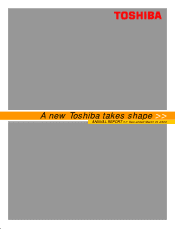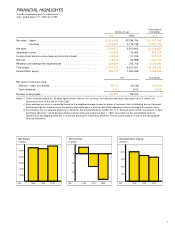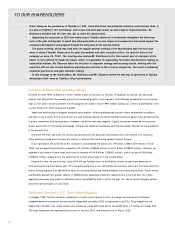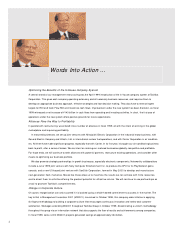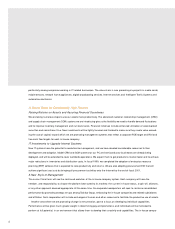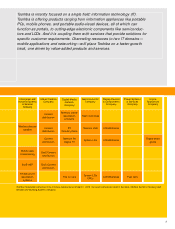Toshiba 2000 Annual Report Download - page 6
Download and view the complete annual report
Please find page 6 of the 2000 Toshiba annual report below. You can navigate through the pages in the report by either clicking on the pages listed below, or by using the keyword search tool below to find specific information within the annual report.
4
Optimizing the Benefits of the In-House Company System
A central strand of our management restructuring was the April 1999 introduction of the in-house company system at Toshiba
Corporation. This gives each company operating autonomy and all necessary business resources, and requires them to
develop an appropriate business approach, effective strategies and fast decision making. They also have to meet stringent
targets for ROI and Cash Flow ROI and maximize cash flows. Improvement under the new system has been dramatic, as fiscal
1999 witnessed a net increase of ¥143 billion in cash flows from operating and investing activities. In short, the first year of
operations under the new system offers positive grounds for future expectations.
Alliances Pave the Way to Profitability
In parallel with restructuring, we entered into a number of alliances in fiscal 1999, all with the intent of winning in the global
marketplace and improving profitability.
In matured businesses, we set up joint ventures with Mitsubishi Electric Corporation in the industrial motor business, with
General Electric Company and Hitachi, Ltd. in international nuclear fuel operations, and with Carrier Corporation in air condition-
ers. All three have made significant progress, especially that with Carrier. In its first year, it brought our air-conditioning business
back to profit, after a series of losses. We are intent on making our matured businesses globally competitive and profitable.
For those ends, we will continue to seek alliances with powerful partners, restructure existing operations, and consider other
means to optimizing our business portfolio.
We also promote strategic partnerships in growth businesses, especially electronic components. Noteworthy collaborations
include a June 1999 joint venture with Sony Computer Entertainment Inc. to produce the CPU for its PlayStation2 game
console, and a new US-based joint venture with SanDisk Corporation, formed in May 2000 to develop and manufacture
next-generation flash memories. Moves like these allow us to maximize the results we can achieve with finite resources,
and to direct them to activities offering the greatest potential for attractive returns. We will continue to use partnerships as
a tool to promote Toshiba’s competitiveness.
Change in Corporate Culture
Of course, reorganization can only succeed if it is backed up by a whole-hearted commitment to success in the market. The
key to that is Management Innovation 2001 (MI2001). Launched in October 1998, this company-wide initiative is applying
Six-Sigma methodology to building a corporate culture that encourages continuous innovation and seeks total customer
satisfaction. We began extending MI2001 throughout Toshiba Group in October 1999, disseminating a uniform methodology
throughout the group via an information network that also supports the flow of results and achievements among companies.
In fiscal 1999, some 4,000 MI2001 projects generated savings of approximately ¥34 billion.
Words Into Action ...

